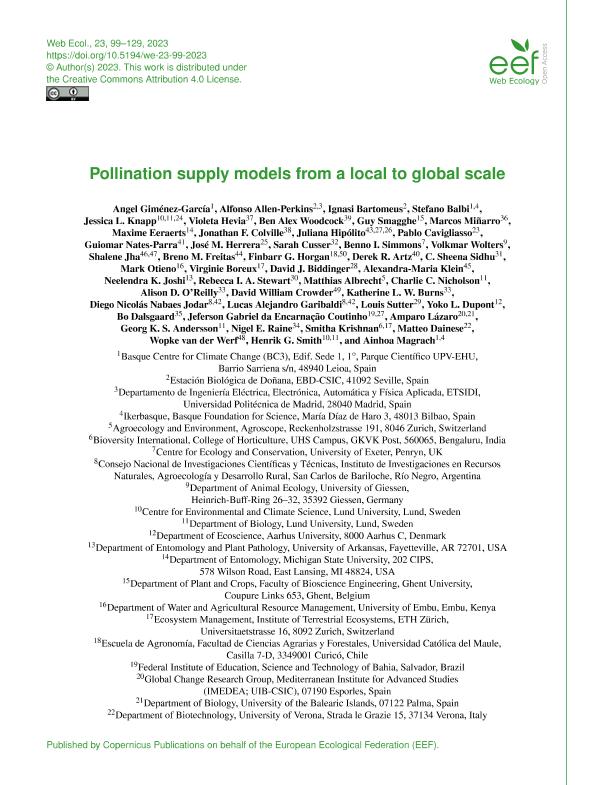Artículo
Pollination supply models from a local to global scale
Giménez García, Angel; Allen Perkins, Alfonso; Bartomeus, Ignasi; Balbi, Stefano; Knapp, Jessica L.; Hevia, Martin; Woodcock, Ben Alex; Smagghe, Guy; Miñarro, Marcos; Eeraerts, Maxime; Colville, Jonathan F.; Hipólito, Juliana; Cavigliasso, Pablo; Nates Parra, Guiomar; Herrera, Jose; Cusser, Sarah; Nabaes Jodar, Diego Nicolás ; Garibaldi, Lucas Alejandro
; Garibaldi, Lucas Alejandro ; Sutter, Louis; Dupont, Yoko L.; Dalsfgaard, Bo; da Encarnação Coutinho, Jeferson Gabriel; Lázaro, Amparo; Andersson, Georg K.S.; Raine, Nigel E.; Krishnan,Smitha; Dainese, Matteo; van der Werf, Wopke; Smith, Henrik G.; Magrach, Ainhoa
; Sutter, Louis; Dupont, Yoko L.; Dalsfgaard, Bo; da Encarnação Coutinho, Jeferson Gabriel; Lázaro, Amparo; Andersson, Georg K.S.; Raine, Nigel E.; Krishnan,Smitha; Dainese, Matteo; van der Werf, Wopke; Smith, Henrik G.; Magrach, Ainhoa
 ; Garibaldi, Lucas Alejandro
; Garibaldi, Lucas Alejandro ; Sutter, Louis; Dupont, Yoko L.; Dalsfgaard, Bo; da Encarnação Coutinho, Jeferson Gabriel; Lázaro, Amparo; Andersson, Georg K.S.; Raine, Nigel E.; Krishnan,Smitha; Dainese, Matteo; van der Werf, Wopke; Smith, Henrik G.; Magrach, Ainhoa
; Sutter, Louis; Dupont, Yoko L.; Dalsfgaard, Bo; da Encarnação Coutinho, Jeferson Gabriel; Lázaro, Amparo; Andersson, Georg K.S.; Raine, Nigel E.; Krishnan,Smitha; Dainese, Matteo; van der Werf, Wopke; Smith, Henrik G.; Magrach, Ainhoa
Fecha de publicación:
04/10/2023
Editorial:
Copernicus Publications
Revista:
Web Ecology
e-ISSN:
1399-1183
Idioma:
Inglés
Tipo de recurso:
Artículo publicado
Clasificación temática:
Resumen
Ecological intensification has been embraced with great interest by the academic sector but is still rarely taken up by farmers because monitoring the state of different ecological functions is not straightforward. Modelling tools can represent a more accessible alternative of measuring ecological functions which could help promote their use amongst farmers and otherdecision-makers. In the case of crop pollination, modelling has traditionally followed either a mechanistic or a data-driven approach. Mechanistic models simulate the habitat preferences and foraging behaviour of pollinators, while data-driven models associate georeferenced variables with real observations. Here, we test these two approaches to predict pollination supply, andvalidate these predictions using data from a newly released global dataset on pollinator visitation rates to different crops. We use one of the most extensively used models for the mechanistic approach, while for the data-driven approach, we select among a comprehensive set of state-of-the-art machine-learning models. Moreover, we explore a mixed approach, where data-derived inputs, rather than expert assessment, inform the mechanistic model. We find that, at a global scale, machine-learning models work best, offering a rank-correlation coefficient between predictions and observations of pollinator visitation rates of 0.56. In turn, the mechanistic model works moderately well at a global scale for wild bees other than bumblebees. Biomes characterised by temperate or Mediterranean forests show a better agreement between mechanistic model predictions and observations, probably due to more comprehensive ecological knowledge and therefore better parameterization of input variables for these biomes. This study highlights the challenges of transferring input variables across multiple biomes, as expected given the different composition of species in different biomes. Our results provide clear guidance on which pollination supply models perform best at different spatial scales – the first step toward bridging the stakeholder-academia gap in modelling ecosystem service delivery under ecological intensification.
Palabras clave:
CROP POLLINATION
,
MODELLING TOOLS
,
ECOLOGICAL FUNCTIONS
,
PREDICTION
Archivos asociados
Licencia
Identificadores
Colecciones
Articulos (IRNAD)
Articulos de INSTITUTO DE INVESTIGACIONES EN RECURSOS NATURALES, AGROECOLOGIA Y DESARROLLO RURAL
Articulos de INSTITUTO DE INVESTIGACIONES EN RECURSOS NATURALES, AGROECOLOGIA Y DESARROLLO RURAL
Articulos(IIPG)
Articulos de INSTITUTO DE INVESTIGACION EN PALEOBIOLOGIA Y GEOLOGIA
Articulos de INSTITUTO DE INVESTIGACION EN PALEOBIOLOGIA Y GEOLOGIA
Citación
Giménez García, Angel; Allen Perkins, Alfonso; Bartomeus, Ignasi; Balbi, Stefano; Knapp, Jessica L.; et al.; Pollination supply models from a local to global scale; Copernicus Publications; Web Ecology; 23; 2; 4-10-2023; 99-129
Compartir
Altmétricas



